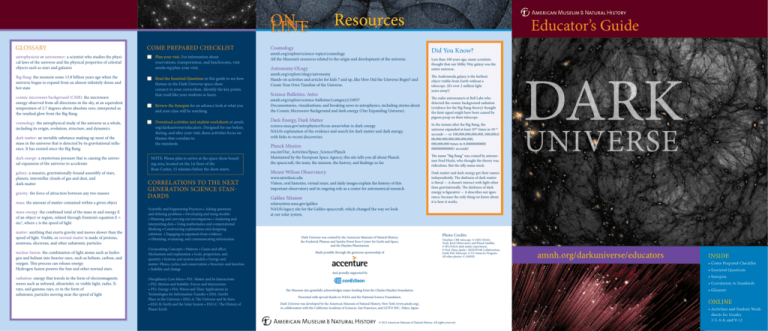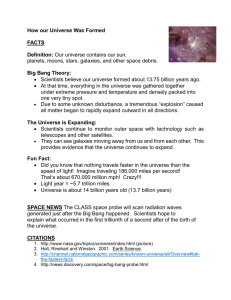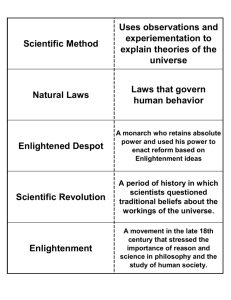
Resources
ONLINE
GLOSSARY
COME PREPARED CHECKLIST
astrophysicist or astronomer: a scientist who studies the physical laws of the universe and the physical properties of celestial
objects such as stars and galaxies
Plan your visit. For information about
reservations, transportation, and lunchrooms, visit
amnh.org/plan-your-visit.
Big Bang: the moment some 13.8 billion years ago when the
universe began to expand from an almost infinitely dense and
hot state
Read the Essential Questions in this guide to see how
themes in the Dark Universe space show
connect to your curriculum. Identify the key points
that you’d like your students to learn.
cosmic microwave background (CMB): the microwave
energy observed from all directions in the sky, at an equivalent
temperature of 2.7 degrees above absolute zero, interpreted as
the residual glow from the Big Bang
cosmology: the astrophysical study of the universe as a whole,
including its origin, evolution, structure, and dynamics
dark matter: an invisible substance making up most of the
mass in the universe that is detected by its gravitational influence. It has existed since the Big Bang.
dark energy: a mysterious pressure that is causing the universal expansion of the universe to accelerate
galaxy: a massive, gravitationally-bound assembly of stars,
planets, interstellar clouds of gas and dust, and
dark matter
gravity: the force of attraction between any two masses
mass: the amount of matter contained within a given object
mass-energy: the combined total of the mass m and energy E
of an object or region, related through Einstein’s equation E =
mc2, where c is the speed of light
matter: anything that exerts gravity and moves slower than the
speed of light. Visible, or normal matter is made of protons,
neutrons, electrons, and other subatomic particles.
nuclear fusion: the combination of light atoms such as hydrogen and helium into heavier ones, such as helium, carbon, and
oxygen. This process can release energy.
Hydrogen fusion powers the Sun and other normal stars.
radiation: energy that travels in the form of electromagnetic
waves such as infrared, ultraviolet, or visible light, radio, Xrays, and gamma-rays, or in the form of
subatomic particles moving near the speed of light
Review the Synopsis for an advance look at what you
and your class will be watching.
Download activities and student worksheets at amnh.
org/darkuniverse/educators. Designed for use before,
during, and after your visit, these activities focus on
themes that correlate to
the standards.
NOTE: Please plan to arrive at the space show boarding area, located on the 1st floor of the
Rose Center, 15 minutes before the show starts.
CORRELATIONS TO THE NEXT
GENERATION SCIENCE STANDARDS
Scientific and Engineering Practices • Asking questions
and defining problems • Developing and using models
• Planning and carrying out investigations • Analyzing and
interpreting data • Using mathematics and computational
thinking • Constructing explanations and designing
solutions • Engaging in argument from evidence
• Obtaining, evaluating, and communicating information
Crosscutting Concepts • Patterns • Cause and effect:
Mechanism and explanation • Scale, proportion, and
quantity • Systems and system models • Energy and
matter: Flows, cycles, and conservation • Structure and function
• Stability and change
Disciplinary Core Ideas • PS1: Matter and Its Interactions
• PS2: Motion and Stability: Forces and Interactions
• PS3: Energy • PS4: Waves and Their Applications in
Technologies for Information Transfer • ESS1: Earth’s
Place in the Universe • ESS1.A: The Universe and Its Stars
• ESS1.B: Earth and the Solar System • ESS1.C: The History of
Planet Earth
Cosmology
amnh.org/explore/science-topics/cosmology
All the Museum’s resources related to the origin and development of the universe.
Astronomy OLogy
amnh.org/explore/ology/astronomy
Hands-on activities and articles for kids 7 and up, like How Did the Universe Begin? and
Create Your Own Timeline of the Universe.
Science Bulletins: Astro
amnh.org/explore/science-bulletins/(category)/24937
Documentaries, visualizations, and breaking news in astrophysics, including stories about
the Cosmic Microwave Background and dark energy (Our Expanding Universe).
Dark Energy, Dark Matter
science.nasa.gov/astrophysics/focus-areas/what-is-dark-energy
NASA’s explanation of the evidence and search for dark matter and dark energy,
with links to recent discoveries.
Planck Mission
esa.int/Our_Activities/Space_Science/Planck
Maintained by the European Space Agency, this site tells you all about Planck:
the spacecraft, the team, the mission, the history, and findings so far.
Mount Wilson Observatory
www.mtwilson.edu
Videos, oral histories, virtual tours, and daily images explain the history of this
important observatory and its ongoing role as a center for astronomical research.
Galileo Mission
solarsystem.nasa.gov/galileo
NASA’s legacy site for the Galileo spacecraft, which changed the way we look
at our solar system.
Dark Universe was created by the American Museum of Natural History,
the Frederick Phineas and Sandra Priest Rose Center for Earth and Space,
and the Hayden Planetarium
Made possible through the generous sponsorship of
Educator’s Guide
Did You Know?
Less than 100 years ago, many scientists
thought that our Milky Way galaxy was the
entire universe.
The Andromeda galaxy is the farthest
object visible from Earth without a
telescope. (It’s over 2 million light
years away!)
The radio astronomers at Bell Labs who
detected the cosmic background radiation
(evidence for the Big Bang theory) thought
the faint signal might have been caused by
pigeon poop on their telescope.
In the instant after the Big Bang, the
universe expanded at least 1050 times in 10-24
seconds — or 100,000,000,000,000, 000,000,0
00,000,000,000,000,000,000,
000,000,000 times in 0.00000000000
0000000000001 seconds!
The name “Big Bang” was coined by astronomer Fred Hoyle, who thought the theory was
ridiculous. But the silly name stuck.
DARK
UNIVERSE
Dark matter and dark energy got their names
independently. The darkness of dark matter
is literal — it doesn’t interact with light other
than gravitationally. The darkness of dark
energy is figurative — it describes our ignorance, because the only thing we know about
it is how it works.
Photo Credits
Timeline: CBE telescope, © GSFC/NASA.
Tools: Keck Observatory and Planck Satellite,
© JPL/NASA; dark matter experiment,
© Prof. Elena Aprile / XENON100 Collaboration;
South Pole Telescope, © US Antarctic Program.
All other photos: © AMNH.
amnh.org/darkuniverse/educators
INSIDE
• Come Prepared Checklist
• Essential Questions
And proudly supported by
• Synopsis
• C orrelation to Standards
The Museum also gratefully acknowledges major funding from the Charles Hayden Foundation.
Presented with special thanks to NASA and the National Science Foundation.
Dark Universe was developed by the American Museum of Natural History, New York (www.amnh.org),
in collaboration with the California Academy of Sciences, San Francisco, and GOTO INC, Tokyo, Japan.
© 2013 American Museum of Natural History. All rights reserved.
• Glossary
ONLINE
• Activities and Student Worksheets for Grades
3-5, 6-8, and 9-12
ESSENTIALQuestions
SYNOPSIS
What does the universe contain?
We’re finding our place
in intergalactic space.
The universe is made up of matter and energy. Visible, or
normal matter, makes up everything we can touch and see, including ourselves, dogs, trees, planets, and stars. In the last 20
years we’ve discovered that this makes up less than 20% of the
total mass of the universe. All the rest of the mass appears to
be made of an invisible substance called dark matter. It emits
and absorbs no light, but we can observe its gravitational effect
on normal matter.
Dark matter holds together the collections of stars called galaxies, and determines where galaxies gather together in clusters
and filaments. A newer discovery is dark energy, a mysterious
pressure that is actually overcoming gravity and causing the
expansion of the universe to accelerate.
In his famous E=mc2 equation, Einstein showed mass m and
energy E to be equivalent, and related through the speed of
light c. This means we can plot them together as mass-energy.
The proportions in the pie chart explain the
observed behavior of the universe.
~25%
< 5%
and traveling through space, can observe this light at
many wavelengths. Space probes extend our reach by sending
back data and samples from other parts of the solar system.
Since scales of space and time are huge and conditions far too
extreme to reproduce in a lab, scientists rely on mathematical
modeling and computer simulations to understand our observations.
What do we know about the early universe?
13.8 billion years ago the entire observable universe was
smaller than an atom, and almost infinitely hot and dense.
This period is what scientists refer to as the Big Bang. Then the
universe inflated to an astronomical size in just an instant. Its
temperatures and density fell, but were still as hot and dense
as the center of a star, so that heavy hydrogen (deuterium) and
helium formed everywhere. No new deuterium has since been
made, so measuring the amount the universe contains allows us
to determine the extraordinary conditions that existed only fifteen minutes after the Big Bang. The universe was still so dense
then that it was entirely opaque: the light was trapped with the
matter. After some 380,000 years (less than 0.01% of the current
age of the universe), as the universe continued to expand and
cool, ionized hydrogen and helium combined with electrons to
form neutral atoms, and the universe became transparent, allowing light to travel freely. This moment — when the universe
became transparent — is captured in the cosmic microwave
background (CMB),
the primordial radiation that still fills the cosmos and
represents the limit of the observable universe.
How has the universe changed over time?
~70%
How do scientists study the universe?
Almost all our information about the universe comes from
light emitted, absorbed, or reflected by the objects in it. Since
light takes time to travel, the farther out into space we look, the
further back in time we see. When we flip a switch,
the light
from the light bulb reaches us in a few nanoseconds, but sunlight is 8 minutes old, light from nearby stars has taken years
or centuries to reach us, and light from distant galaxies can
be billions of years old. Telescopes on Earth, in orbit around
Earth and the Sun,
Ever since the Big Bang, the universe has been expanding. It
contains the same amount of matter but is now a
thousand times larger and cooler than it was at the
moment recorded in the CMB. Over hundreds of millions of
years, gravity acted on the small differences in the distribution
of mass present at the time of the CMB. This formed clumps
of matter that then collapsed inward to form the first stars
and tiny galaxies, and then clusters and filaments of far larger
galaxies. These clusters and all they contain are bound together
by gravity; they do not expand. At the same time, cosmic space
continues to stretch, carrying clusters of galaxies with it. Until
1998 the prevailing theory was that gravity should slow down
the expansion of the universe. Instead, scientists discovered
that gravity is being overcome by a mysterious pressure. Labeled dark energy, it has been accelerating this expansion for
the last five billion years and is expected to continue to do so.
Out a hundred million light
years from Earth, every point
of light is an entire galaxy, each
containing billions of stars. In the
last hundred years, we’ve learned
where these galaxies are, what
they’re made of, and how they got
Our galaxy, the
to be that way. We’ve learned that
Milky Way
the universe was born in a fiery instant
almost 14 billion years ago, and has been expanding and evolving ever since.
The Milky Way has lots of company.
Never before have humans known so much about nature on
the grandest scales. We’ve also begun to glimpse how much we
still don’t know. This story begins in the 1920s
at California’s Mt. Wilson observatory, when astronomers
discovered that the Andromeda nebula was actually a galaxy,
like our own Milky Way, and that it’s very far away. As they
probed deeper, they saw other galaxies and were astonished to
discover that the more distant ones were moving away from us
at greater speeds. This implies that cosmic space is constantly
stretching, carrying untold numbers of galaxies with it.
BEHIND THE SCENES:
MAKING THE SHOW
Since then three extraordinary satellites have mapped this light
in great detail, revealing the fundamental composition of the
universe. More evidence for the Big Bang theory has come from
measuring the abundance of hydrogen, deuterium, and helium.
Scientists predicted that these light atoms formed by fusion
during the initial extremely hot phase of the universe. In 1995
NASA’s Galileo mission found that the amount of deuterium
locked up in Jupiter’s atmosphere confirmed this prediction.
The universe turns out to be way darker than we
thought.
While scientists were piecing together the history of atoms,
evidence emerged that most of the universe isn’t made of atoms
at all. It now appears that all the glowing stars are the glittering
froth on an invisible cosmic ocean made of what astronomers
call dark matter and dark energy.
astronomers couldn’t explain.
Another astonishing discovery occurred in 1998. Astronomers
had predicted that the gravity exerted by all this matter would
act like a brake, slowing the expansion of the universe. Instead,
by measuring the distances and speeds of exploding stars called
supernovas, they learned that the expansion of the universe is
accelerating. The pressure causing the acceleration has been
labeled
dark energy.
We’re in the dark (for now).
We don’t understand the nature of dark energy yet,
although it makes up nearly 70% of the total mass-energy of the
universe. Dark matter accounts for almost all the rest. Visible
matter — all that we are, all that we’ve ever seen or touched —
amounts to less than 5% of the
observable universe.
Space shows are a 21st-century example of a long-standing
Museum tradition: scientists collaborating with artists and
educators to bring accurate depictions of the natural world
to the public.
The visualizations in Dark Universe are based on real data:
millions of actual astronomical observations
combined with physics-based numerical models.
Powerful computers make complex calculations in order to
simulate cosmic phenomena based on these models. The
visualizations rely heavily on the Digital Universe, a threedimensional atlas of all astronomical objects whose distance
from Earth is known, which is maintained by Museum
astrophysicists.
The universe extends far beyond what we
can see.
We can only observe the part of the universe close enough for
its light to have reached us over cosmic history. This sphere
is our observable universe. Since every observer occupies the
center of their own observable universe, the entire universe
must be much larger than any observer can see, and could even
be infinite. Peering into the dark, we stand on the threshold of
many more discoveries.
A crazy idea — the Big Bang — isn’t crazy
after all.
Since the universe cools as it expands, it must once have been
far hotter — and denser — than it is today. Skeptics ridiculed this “Big Bang” theory. Then, in 1964, scientists testing a
radio antenna at
New Jersey’s Bell Labs accidentally recorded lowlevel light
coming from all directions: the cosmic microwave background. This
turned out to be the
oldest light ever seen: light emitted right after the hot
Big Bang itself.
A radio antenna detected something
The cosmos is expanding faster and faster.
To make the show’s visualization of the Milky Way, scientists used
supercomputer models to simulate the galaxy and artists assigned
colors and brightnesses to objects within it — like the pink areas that
represent the youngest star-forming regions.
Dark matter neither emits nor absorbs light. But its gravitational
influence on galaxies betrays its presence.
We can’t see dark matter because it neither emits nor
absorbs any sort of light. But its gravity interacts with
the normal matter that we can see — like stars and
galaxies — which is how astronomers know it exists.
The gravity generated by dark matter is necessary for the largescale web-like structure of today’s universe to form. Scientists
are using detectors deep beneath Earth’s
surface, at particle accelerators, and even on the International
Space Station, to try to find out what it is.
Since every observer in the universe occupies the center of their
own observable universe, the entire universe must be bigger than
what we can observe.
Leading scientists from around the world convened at the
Museum to shape the broad story of Dark Universe and
identify the best data to convey it. To bring the story to
the dome, the production team worked directly from these
datasets, consulting closely with scientists. Digital artists
recreated space probes in minute detail in close consultation
with engineers and scientists who worked on the missions.
The visual experience is brought to life with a live-recorded
original soundtrack, mixed with state-of-the-art, spatialized
sound effects and narration.








